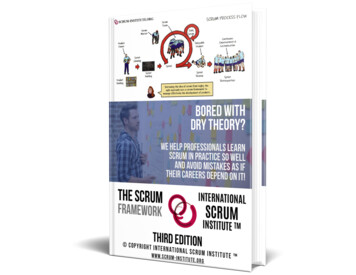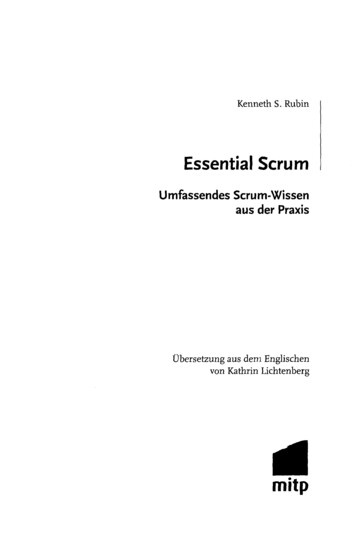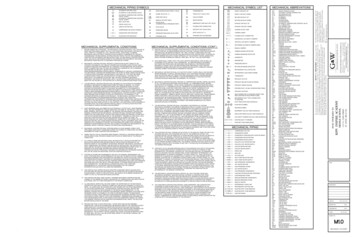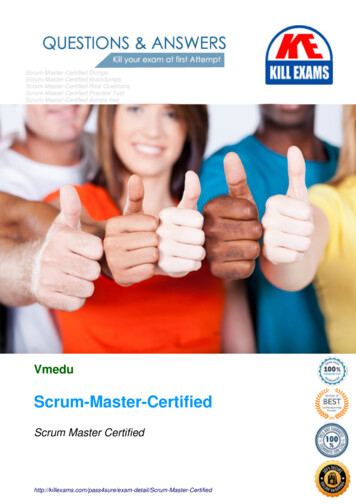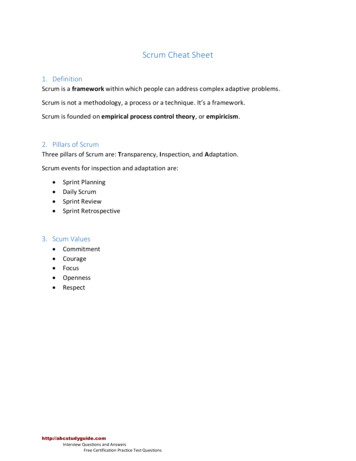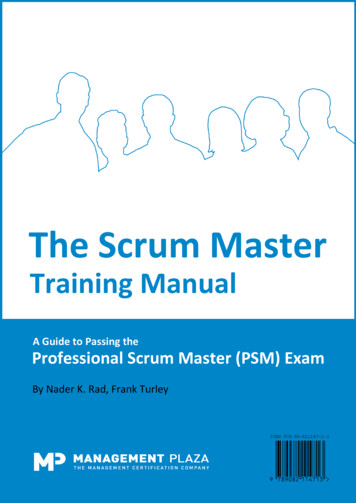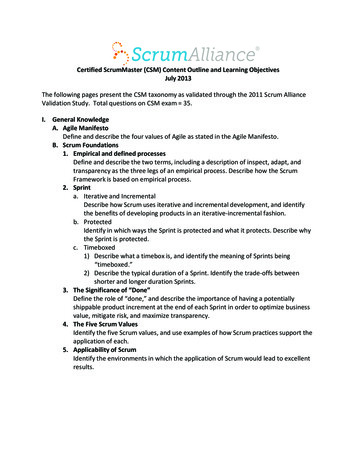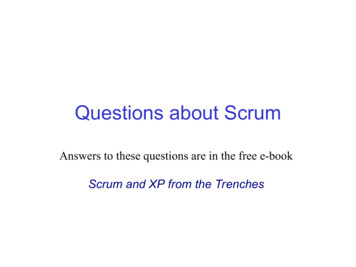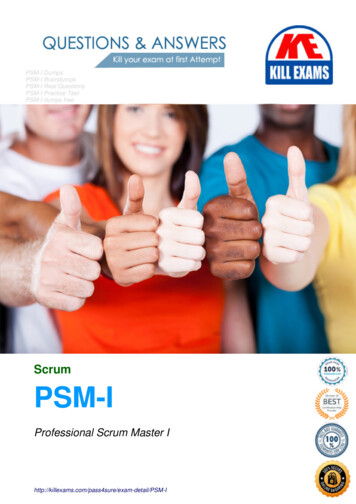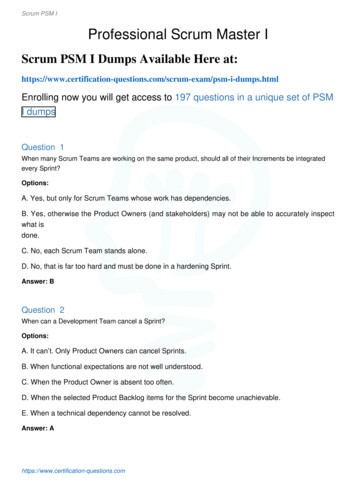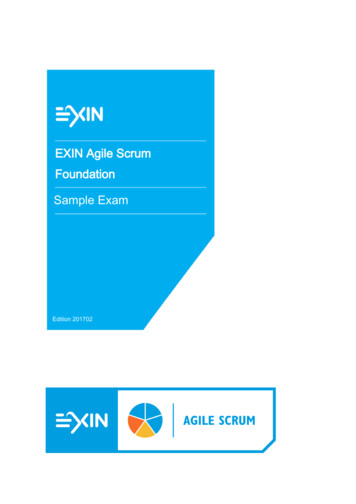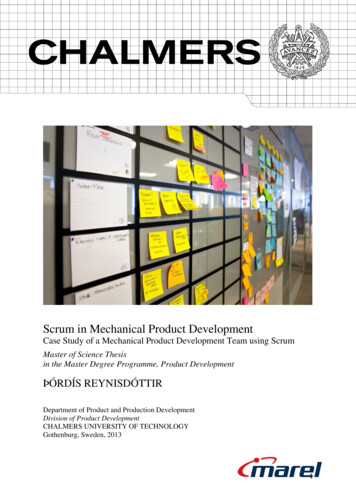
Transcription
Scrum in Mechanical Product DevelopmentCase Study of a Mechanical Product Development Team using ScrumMaster of Science Thesisin the Master Degree Programme, Product DevelopmentÞÓRDÍS REYNISDÓTTIRDepartment of Product and Production DevelopmentDivision of Product DevelopmentCHALMERS UNIVERSITY OF TECHNOLOGYGothenburg, Sweden, 20131
MASTER’S THESISScrum in Mechanical Product DevelopmentCase Study of a Mechanical Product Development Team using ScrumMaster of Science Thesis in the Master Degree Programme, Product DevelopmentÞÓRDÍS REYNISDÓTTIRSUPERVISOR & EXAMINER:GÖRAN GUSTAFSSONDepartment of Product and Production DevelopmentDivision of Product DevelopmentCHALMERS UNIVERSITY OF TECHNOLOGYGothenburg, Sweden, 2013
Scrum in Mechanical Product DevelopmentCase Study of a Mechanical Product Development Team using Scrum ÞÓRDÍS REYNISDÓTTIRSupervisor & Examiner: Göran Gustafsson, Ph.D.Chalmers University of TechnologyDepartment of Product and Production DevelopmentSE- 412 96 GothenburgSwedenTelephone: 46(0)31-772 10 00Gothenburg, Sweden, 2013
AbstractThe purpose of this study was to investigate if it would be possible for a mechanical productdevelopment team to use Scrum, an Agile Development framework.The Agile philosophy and methods have revolutionized the software development industry in thelast decade, and therefore it was of interest to see if this new way of working would be applicable inhardware development. The study focuses on if Scrum can be applied in mechanical productdevelopment, and if it needs any adaptations. Three case studies of Scrum or Agile methods used inmechanical and hardware design and development are presented. The primary case study follows amechanical product development team through their 7-month experiment of using Scrum. The teamin question co-operates with an embedded software development team in new productdevelopment. Two supplementary case studies are presented: The first on a single cross-functionalhardware team using a Scrum like method, and the second, on an organization re-structuring. Themethods used in order to form the case studies were observations, interviews and informalconversations.The results indicate that it is possible for a mechanical development team to use the Scrumframework, with some minor adaptions of the framework. The team in the primary case made use ofall main aspects of the framework, but the deviations were that the team was not cross-functionaland a working product or product increment is not produced every iteration. The results alsoindicate that using the framework improved the team’s work and progress, and the team decided tocontinue using the framework after the experiment. The conclusion is that Scrum can be used in ahardware environment, by mechanical development teams. Some adaptations might be needed,depending on each case, but this is also recommended in the literature to software developmentteams.Key words: Product development, Scrum, Agile, Lean Product Development, Hardware, MechanicalI
AcknowledgementsFirstly, I specially want to thank Mr. Ásgeir Ásgeirsson, the Innovation Community Director at MarelGRB, for believing in me and giving me the opportunity to work for Marel and getting the chance todo my Master Thesis project there. Secondly, I want to thank Ms. Rósa Björg Ólafsdóttir, AgileCenter Manager at Marel GRB, for her full support, insightful discussions and mentorship throughoutthe project. I also want to thank her for the interest shown in my work and the input she provided.Thirdly, I want to thank IC-Fish, the development teams and its management, for giving me thechance to perform my study with them, and the time we have had working together throughout theexperiment. Special thanks to the mechanical team for their patience and allowing me to observeand question them.In addition to this, I want to thank those who gave their time and provided me with further casestudy material on the use of Agile and Scrum in hardware product development. Firstly, I thank Mr.Martin Labecker, Line Manager at SAAB EDS, Gothenburg Sweden, for giving me the chance to visitand see the way one of their hardware teams works. I want to thank Mr. Henrik Lindsjö for giving mean insight into the new organization at Andritz Hydro AB, Service and Rehab division in Sweden, andthe interesting discussions we had through our correspondence. I also want to thank Mr. MikaelLundgren, Agile and Lean Product Development Expert, for his correspondence, his further insightinto the organizational restructuring at Andritz Hydro and insight into how Scrum is used inhardware and mechanical development in the industry.I want to thank my family for their unconditional support throughout my studies and project work.Last but not least, I want to thank my supervisor Dr. Göran Gustafsson, believing in the project andme and seeing the potential of taking it to a higher level. His enthusiasm, guidance and support, andinspired me during the project work. I am also very grateful to him for introducing me to LeanProduct Development.II
III
Table of ContentsAbstract . IAcknowledgements . IITable of Contents . IVList of Abbreviations . VII11.11.21.322.12.22.33Introduction . 1Purpose. 1Delimitations . 1Outline of the Thesis . 2Problem formulation . 3Introduction to Marel GRB . 3The Problem Definition . 3Research Questions . 4Methodology. 53.1Research Approach . 53.2Literature Review . 53.3Observations. 63.4Interviews . 63.5Case Studies . 63.5.1 Primary Case Study . 73.5.2 Supplementary Case Studies . 73.6Validity . 74Theoretical Framework . 94.1Agile Software Development . 94.1.1 History and Background . 94.1.2 Manifesto for Agile Software development. 94.1.3 The Waterfall Model . 104.1.4 Traditional vs. Agile . 124.1.5 Agile Planning . 124.1.1 Success Factors in Deployment and Sustaining of Agile Methods . 154.1.2 Kanban . 154.2Scrum .164.2.1 What is Scrum?. 164.2.2 Overview of the Scrum framework . 174.2.3 The Scrum Roles . 184.2.4 Scrum Artefacts and Definitions . 204.2.5 Scrum Events . 214.2.6 Scrum Values . 234.2.7 Scrum by the Book? . 234.3Agile in non-Software & Hardware development .24IV
4.3.14.3.24.3.35Agile methods applicable to aircraft systems integration . 25The Johns Hopkins CubeSat Case . 26Wikispeed Modular Car . 28Main Case Study: Marel GRB . 305.1Introduction to Marel .305.1.1 Agile and Scrum at Marel GRB. 315.2The Case Study Introduction: Mechanical PD team using Scrum .335.3Part 1: The Scrum Start-up .345.3.1 The First Training and Planning Session . 345.3.2 The First Days of Scrum . 375.3.3 End of the First Sprint - The Mechanical Team Interview . 395.4Part 2: Remote Observation .445.4.1 Main Events . 445.4.2 General Observations . 455.4.3 Scrum Master Hand-Over . 465.5Part 3: Observation as a Scrum Master .515.5.1 Main Events . 515.5.2 General Observations . 525.5.3 Release Planning & New Sprint Planning Method . 535.5.4 Summary of Team and Product Owners Final Results . 565.5.5 Team Interview Results .
study material on the use of Agile and Scrum in hardware product development. Firstly, I thank Mr. Firstly, I thank Mr. Martin Labecker, Line Manager at SAAB EDS, Gothenburg Sweden, for
